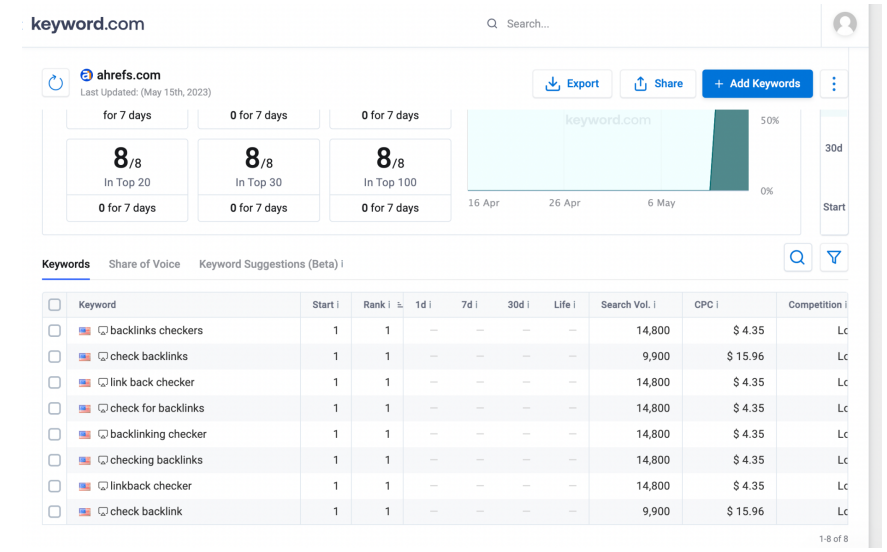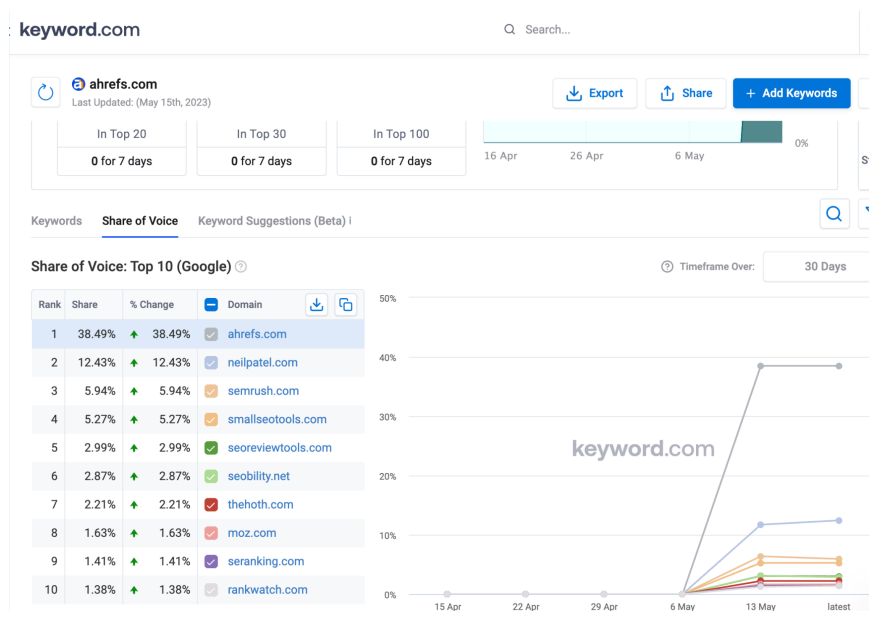[Live Webinar]: Future-Proof Your SEO: Compete for Visibility in the Age of GEO — Register Now!
Do you know how to analyze keyword data? Or how to do a SERP analysis so that you know which keywords to target? Or which keywords are dominated by large websites that make it nearly impossible to rank for? It’s pretty straightforward — you analyze keyword data.
Keyword data is the set of metrics you get when you input a specific keyword into an SEO tool for analysis. This guide will discuss these keyword metrics and how to analyze keywords to inform your SEO strategy.
Search volume refers to the number of times a particular keyword or phrase is searched for in a given period, usually every month. You can view this in your Keyword.com dashboard or any other SEO tool.

Search volume differs based on location. This means a keyword might have a high volume in a particular location and a lower volume elsewhere. If you’re a location-specific business, this data shows you what the people around you are searching for, so you can tailor your strategy accordingly.
Using search volume data, you can identify high-volume keywords. While high-volume keywords may have a lot of competition, they could bring significant traffic to your website if you rank well for them. Conversely, you can also identify low-volume keywords with less competition and less traffic potential.
For example, if you are a company that sells shoes online, you may find that the keyword “running shoes” has a much higher search volume than “trail running shoes.” By targeting “running shoes,” you may be able to drive more traffic to your website, but you will also face more competition from other companies targeting the same keyword.
Keyword difficulty is a metric that helps you determine how hard it is to rank for a specific keyword. It considers the number of websites that are already ranking for that keyword, as well as the authority of those sites. On Keyword.com, we group difficulty into three categories: Low, medium, and high.

Using keyword difficulty data, you can identify easier keywords to rank for, allowing you to focus your efforts on them rather than competing with more established sites for highly competitive keywords.
For example, if you are a new blogger in the travel niche, you may find it difficult to rank for the keyword “travel tips,” which has a high keyword difficulty score. Instead, you could target a less competitive keyword like “solo travel tips,” which has a lower keyword difficulty score.
Cost per click (CPC) is the amount of money an advertiser pays for each click on their ad in paid search results. CPC data is helpful for SEO because it can give you an idea of the commercial intent behind a particular keyword.
For example, if a keyword has a high CPC, it may indicate that people who search for that keyword are more likely to be looking for products or services to buy. This could be valuable information if you are trying to optimize your website for e-commerce sales.
It also helps with attribution for your SEO performance. If you’re ranking tops for a keyword with a high cost-per-click and driving conversions, you’re ultimately saving the money your business would have otherwise spent on paid ads.
Share of voice (SOV) is a metric that measures how much visibility your website has compared to your competitors for a particular set of keywords. It considers the number of times your website appears in search results for those keywords, as well as the position of your site in those results.

Using SOV data, you can identify areas where you may be losing visibility to competitors and work to improve your rankings for those keywords.
For example, if you are a company that sells home fitness equipment, you may find that your SOV is lower for the keyword “treadmill” compared to your competitors. By analyzing the search results for that keyword, you may discover that your competitors have better content or more authoritative websites. Armed with this information, you can develop a strategy to improve your rankings for that keyword.
Search intent refers to the reason behind a user’s search query. Understanding search intent is crucial for SEO because it helps you create content that aligns with the user’s needs and expectations. This step requires you to doa SERP analysis by reviewing the types of pages and search results that are displayed for a specific keyword. You can start by determining the search intent of the pages that appear in the SERPs.
There are generally four types of search intent:
Using search intent data, you can optimize your content to match the user’s intent better, leading to higher click-through rates, longer time spent on your site, and, ultimately, better rankings.
For example, if you are a company that sells health supplements, you may find that the keyword “best protein powder” has a high search volume, but the search intent behind it is primarily informational. This means that users are looking for information about protein powders rather than looking to buy them. To optimize your content for this keyword, you could create a blog post that provides valuable information about protein powders, such as their different types, benefits, and how to use them. This better aligns with the user’s intent, leading to higher engagement and better rankings for that keyword.